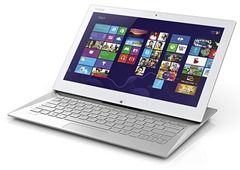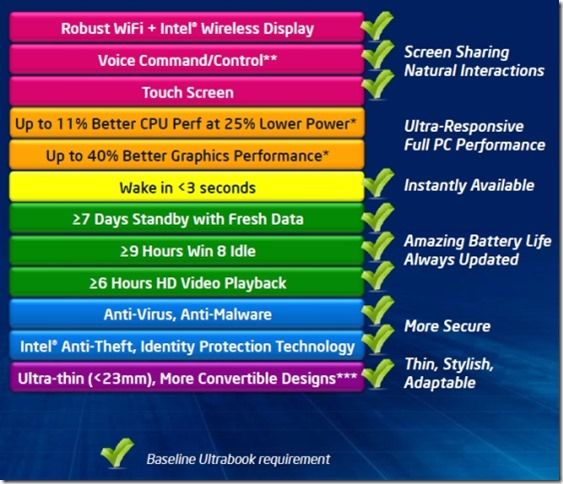 We’ve already heard that all Ultrabooks based on 4th-Gen Core (Haswell) will have to have WiDi capability and touchscreens but PCWorld have just published some more details from Intel.
We’ve already heard that all Ultrabooks based on 4th-Gen Core (Haswell) will have to have WiDi capability and touchscreens but PCWorld have just published some more details from Intel.
Ultrabook (3rd Gen) Requirements:
- Max thickness 23mm (was 19mm for pure laptops)
- Must be hardware ready for voice command. (We assume array microphones for beam forming or noise cancelation)
- 6 hours of HD video playback
- 9 hours Windows 8 idling time
- Wake from sleep in three seconds
- WiDi support
- Touchscreen
- Antivirus and antimalware software to be preinstalled. Identity Protection Technology support.
It’s a strange set of requirements but we suspect it’s just the public face of the requirements that are given to manufacturers. Having said that, surely they could put their foot down on 1366×768 screens now?
Note that Connected Standby Ultrabooks will have to have the OS on an SSD due to Microsoft’s requirements. USB3.0 is a given as the controller is built into the chipset. WiDi support means either an Intel Ethernet module or one using the licensed technology. Broadcom is the only third party we know of that has licensed WiDi so far.












The Razor Blade doesn’t have a touchscreen but it has a Haswell processor
The Razer Blade also doesn’t have a U or Y series processor based platform which has all the power enhancements necessary to get the great battery life increase Intel is projecting.
The non-U and Y chips are going to be barely better in battery life.
It seems that the non-U and Y chips aren’t much better in performance and power consumption. Why do only the U and Y chips get the aggressive power management features instead of all of them?
Not all Haswell chips are going get the huge efficiency improvement? Not even the notebook M chips? I guess I won’t be upgrading my X230.
I’ll probably look into AMD or older Intel chips for upgrading my Core 2 Quad Linux HTPC/file server/video encoder. I was hoping for a smaller and quieter system.
Any chances of quad core U or even Y chips? I’d like to use the extra cores for software x264 encoding (no Quick Sync) and running multiple virtual machines.
I could hope for quad core M chips in small notebooks (not quite ultrabooks) but it seems I won’t get the big power efficiency boost.